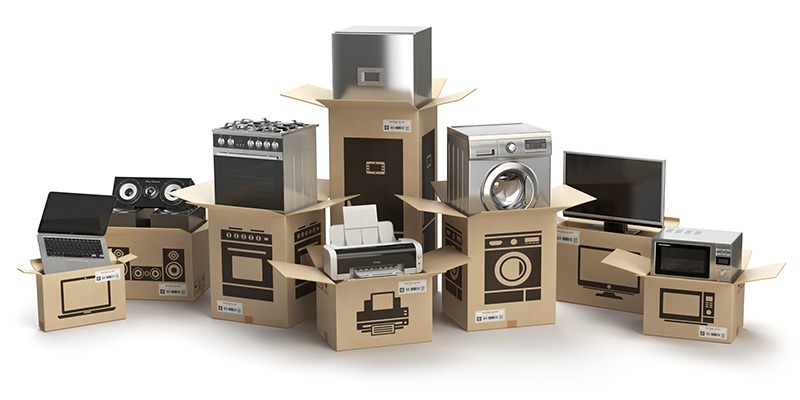We recommend the following procedures when moving electronics to prevent any damage. If you take these steps before moving, your components should arrive intact.
 Audio and Video Components
Audio and Video Components
If you don’t have the owner’s manuals, or even if you do (they can often be found online), you may want to draw a diagram or take a photo of the wiring configuration to help you reconnect your components correctly after your move. Another good tip is to put small pieces of matching colored tape on the ends of the cables and on the corresponding inputs and outputs of the components.
Remove all discs from your CD and DVD players before packing to prevent scratches to your discs and damage to the laser in your player. This is also a good time to make sure that all your discs are back in their proper cases. Some players come equipped with a “transport screw” usually located underneath the unit (check the owner’s manual). Tighten this screw before you pack your player, which will immobilize parts of the mechanism.
If your unit comes with a cartridge (stacker) for multi-play, remove it before packing. The cartridge can be wrapped and packed in the same box as the player. All trays, whether single or multi-play, should be in the closed position before packing.
The best way to move your components is in the original boxes with the original packing. If you don’t have them, use boxes with enough room for adequate packing material. Your mover can provide a sturdy packing container and materials. Packing material should snugly fill the excess room in the box so that the unit will not move around. Plastic bubble sheets make ideal packing material. Newspaper is not recommended, as it may not securely hold the unit in place.
If you have a remote control, be sure to pack it in the same box as your player. All wiring used with your player should also be packed in the same box if you have room. Seal the box with reliable packing tape. Use this same packing method for packing your receiver, speakers and other audio and video components.
Plasma and Flat-screen Monitors
Plasma TV displays can be difficult to ship because they are essentially two thin panels of glass with plasma, an electrically-charged gas, held in suspension between them. They are delicate and relatively heavy. LCD screens, on the other hand, are lighter and less susceptible to damage, but still require careful handling.
If you are considering doing your own packing (not recommended for plasma TVs) be sure to let you mover know during the estimate that your shipment will include the TV and that special handling or crating may be required.
While plasma televisions are susceptible to damage from extreme temperatures, mishandling and from operating at high altitudes, they are shipped worldwide by their manufacturers without damage. The key is the packing. Whenever possible, you should use the manufacturer’s original packing container if you have kept it. If not, your mover can provide you with a special shipping container, or the unit should be packed and shipped in a container that meets the manufacturer’s specifications as closely as possible.
Plasma TVs should always be shipped and stored in an upright position. Shipping the units double-boxed and upright strapped to a pallet is recommended.
If storage is involved, the requirements vary by manufacturer, but plasma TVs should be stored in a climate-controlled warehouse where the temperature does not fall below 15 degrees F or above 122 degrees F, and where the humidity does not fall below 10 percent or exceed 90 percent with no condensation. Such units should not be stored at altitudes above 9,800 feet.
Some manufacturers recommend using only third-party specialists for dismounting and preparing plasma TVs for shipping, with professional installation at the destination for re-installation.
Personal Computers
Manually back up all your data. Remove any CDs from the disc drive and close all drive doors. Shut down the computer and the monitor before disconnecting them. Draw a diagram or take a photo of the wiring configuration to help you hook up your system up after your move. You may want to label each cable according to its corresponding piece of hardware (use this method for your printer, monitor, modem, scanner, etc.)
Use the original boxes if you have them. Otherwise, use boxes larger than the equipment and use plenty of packing material, especially on the sides.
Printers and Scanners
Again, the original packing box and material is the best choice for transport because they are customized to fit your specific items. Remove ink cartridges from printers and pack them separately. If you are moving a laser printer, remove the laser ink cartridge as the toner may spill and contaminate the laser engine.
At Your Destination
Avoid plugging in electronics on delivery day if possible. You should wait 24 hours to allow the units (TV, stereo or otherwise) to acclimate to room temperature and humidity, especially during colder months.
Special items
During an estimate, be sure the mover is aware of any particularly unusual items you’ll be taking with you, such as a chandelier or in-ground swing set. Movers often rely on their own or outside specialists to handle disassembling and/or crating (and uncrating and reassembling) such items as grandfather clocks, high-end appliances and home gyms.


